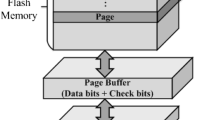Abstract
The embedded Flash (eFlash) technology can be subject to defects creating functional faults. In this paper, we first generalize the electrical model of the ATMEL TSTAC™ eFlash memory technology proposed in [10]. The model is composed of two layers: a functional layer representing the Floating Gate (FG) and a programming layer able to determine the channel voltage level controlling the Fowler-Nordheim tunneling effect. The proposed model is validated by means of simulations and comparisons with ATMEL silicon data. Then, we present a complete analysis of actual resistive defects (open and short) that may affect the ATMEL TSTAC™ eFlash array by considering the proposed model on a hypothetical 4 × 4 array. This analysis highlights the interest of the proposed model to provide a realistic set of fault models that has to be tested, thus enhancing existing solutions for TSTAC™ eFlash testing.

















Similar content being viewed by others
References
Aritome S, Shirota R, Hemink G, Endoh T, Masuoka F (1993) Reliability issues of flash memory cells. Proc IEEE 81(5):776–788
Dickson JF (June 1976) On-Chip high-voltage generation in NMOS integrated circuits using an improved voltage multiplier technique. IEEE J Solid State Circ 11(3):374–378
Ginez O, Daga J-M, Combe M, Girard P, Landrault C, Pravossoudovitch S, Virazel A (2006) An overview of failure mechanisms in embedded flash memories. Proc. of IEEE VLSI Test Symposium, pp 108–113
Ginez O, Daga J-M, Girard P, Landrault C, Pravossoudovitch S, Virazel A (2007) Retention and reliability problems in embedded flash memories: analysis and test of defective 2T-FLOTOX tunnel window. Proc of the IEEE VLSI Test Symposium, pp 47–52
Ginez O, Daga J-M, Girard P, Landrault C, Pravossoudovitch S, Virazel A (Jun 2009) A SPICE-Like 2T-FLOTOX core-cell model for defect injection and faulty behavior prediction in eFlash. J Electron Test-Theor Appl 25(2–3):127–144
IEEE Standard Definitions and Characterization of Floating-gate Semiconductor Arrays. IEEE 1005–1998, Revision of the IEEE std. 1005–1991
Larcher L, Padovani A, Pavan P, Rimmaudo I, Calderoni A, Molteni G, Gattel F, Fantini P (2007) Modeling NAND flash memories for circuit simulations. Simul Semicon Process Dev 12:293–296
Lenzlinger M, Snow EH (January 1969) Fowler-Nordheim tunneling into thermally grown SiO2. J Appl Phys 40:278–283
Mauroux P-D, Virazel A, Bosio A, Dilillo L, Girard P, Pravossoudovitch S, Godard B (2009) NAND flash testing: a preliminary study on actual defects. Proc. of IEEE International Test Conference, poster 13
Mauroux P-D, Virazel A, Bosio A, Dilillo L, Girard P, Pravossoudovitch S, Godard B, Festes G, Vachez L (2010) A two-layer SPICE model of the ATMEL TSTACTM eFlash memory technology for defect injection and faulty behavior prediction. Proc. of IEEE European Test Symposium, pp 81–86
Mohammad M, Saluja K (2001) Flash memory disturbances: modeling and test. Proc. of the IEEE VLSI Test Symposium, pp 218–224
Mohammad M, Saluja K (November 2003) Simulating disturb faults in flash memories using SPICE compatible electrical model. IEEE Trans Electron Dev 50(11):2286–2291
Pavan P, Bez R, Olivo P, Zanoni E (August 1997) Flash memory cells—an overview. Proc IEEE 85(8):1248–1271
Semiconductor Industry Association (SIA) (2009) International technology roadmap for semiconductors (ITRS)
Sharma A-K (1997) Semiconductor memories: technology, testing and reliability. IEEE Press, Piscataway
Author information
Authors and Affiliations
Corresponding author
Additional information
Responsible Editor: C. A. Papachristou
This paper is an extended version of a previously published paper. Main contributions of this paper with respect to [10] are:
-A generalization of the model initially proposed in [10] to the case of multiple word-lines, -A complete analysis of actual resistive defects (open and short) that may affect the ATMEL TSTAC/ eFlash array, -A fault modeling of actual resistive defect injection.
Rights and permissions
About this article
Cite this article
Mauroux, PD., Virazel, A., Bosio, A. et al. Analysis and Fault Modeling of Actual Resistive Defects in ATMEL  eFlash Memories.
J Electron Test 28, 215–228 (2012). https://doi.org/10.1007/s10836-012-5277-4
eFlash Memories.
J Electron Test 28, 215–228 (2012). https://doi.org/10.1007/s10836-012-5277-4
Received:
Accepted:
Published:
Issue Date:
DOI: https://doi.org/10.1007/s10836-012-5277-4




